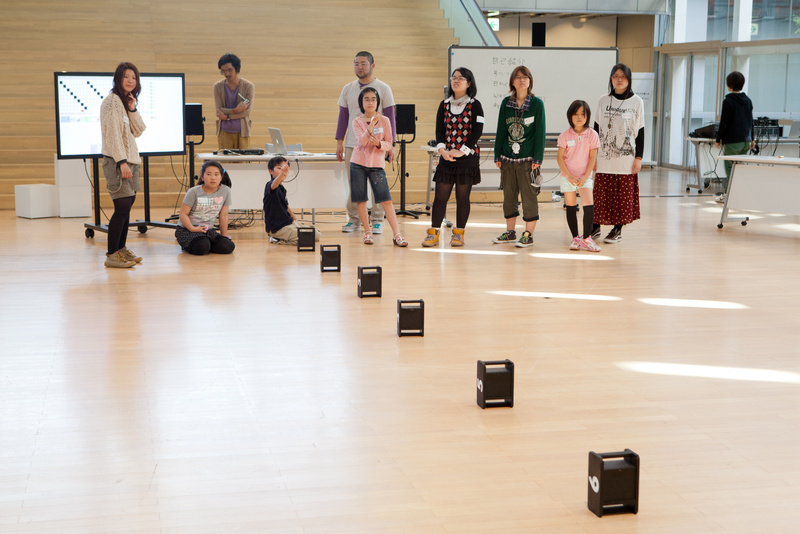Acoustic perception is a mechanism in which vibrations originating from a sound source oscillate the air, and are perceived as "sound" as soon as the vibrating air hits the eardrum. As there is no direct contact of the sound source with the eardrum, the transmission happens via bone conduction, and with the exception of underwater hearing, humans can perceive sound more or less exclusively through the vibration of air. By sensing minute changes in the vibration, we unconsciously detect the presence of obstacles in the acoustic field, and are even able to assess distances and other characteristics of the surrounding space, such as construction materials for example.
Integrating lectures and exercises, this workshop aimed to rediscover human hearing that we usually don't think much about in daily life, and focus at once on the aspect of "space" that up to now has been considered less important in music production. Utilizing an originally devised wireless speaker system, participants worked out a novel approach to the "creative potential of sound" by treating "time" and "space" as equivalent elements in musical composition.
Workshop details
Duration: 3 hoursNumber of participants: 8 Target group: Primary-school students (4th grade) and older
Workshop program
- Introduction
- Ear cleaning
- Learning about the human ear; types of artificial sound; the characteristics of sound
- Blind tour
- Explanation of wireless speakers
- Composition with space and time
- Presentation
- Review
Topics
Ear cleaning
The purpose of this exercise is to sharpen the participants' sense of hearing by having them calm down and identify as far as possible individual sounds their ears pick up.In order to make participants realize how exercise can improve the sensitivity of the ear, the workshop is carried out twice with presentations/interviews sandwiched in between. Through this process, participants learn on an experiential basis how to focus on the sense of hearing, and how the human brain filters sounds from the myriad sounds that reach our ears every day, enabling us to hear only what we need to hear.
Blind walk
The participants walk in groups of two - one of them blindfolded, to be guided by the other - around the part of the building where the workshop takes place. Completely cut off from information provided by the sense of vision, which is said to be accounting for more than 80 percent of all information humans gather from the environment, participants focus on sensory input from the senses of hearing and touch instead, and thus re-evaluate actions that are integral parts of daily life. Through this exercise, participants learn how sounds are perceived differently depending on room sizes, flooring and wall materials, and the presence or absence of obstacles, and are made aware of the fact that our behavior in daily life is based on such differences as a silent assumption.
Wireless speaker system
This system combines eight wireless speakers and appropriate sequencer software, both of which were developed by the YCAM InterLab team for this workshop. In order to ensure a smooth yet dynamic process of spatial composition, the speakers were conceived with no cables or other objects that may interfere with the participants' actions, while all necessary components (radio, battery, amplifier, etc.) are built-in.
Composition with space and time
With the help of special software, 16 bars each of phrases of artificial sounds such as sine waves, rectangular waves and white noise, are played from the eight speakers, and together form a piece of music. Even when simply playing the sounds in order from speakers 1 through 8, arranging the speakers in different layouts - a straight line, a circle surrounding the participants, etc. - creates totally different impressions.
The results also largely depend on the room's characteristics and the way the speakers are installed - behind a wall, or facing toward the ceiling for example. After gaining a basic understanding of how spatial characteristics affect the perception of sound, participants finally attempt a composition with space and time, modifying the signal timing and placement of each speaker. Through their own experience of working with sound, participants become aware of the important role of "spatial composition" - the creation of reverberation by placing sound sources in a room - in addition to the aspect of "temporal composition" - the arrangement of sounds on one timeline - that has been emphasized in the fields of musical composition and sound design.









